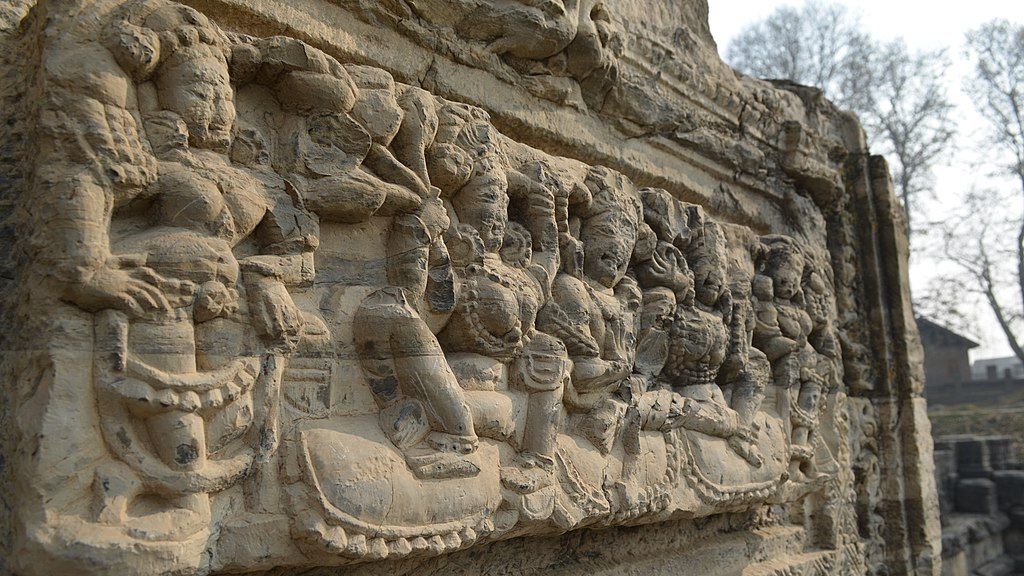- Visitor:19
- Published on:
“The River of Kings” As a Flow of Exemplars
Governance and kingship in the Rājataraṅgiṇī are evaluated according to certain moral principles with which Kalhaṇa frames his composition.

Governance and kingship in the Rājataraṅgiṇī are evaluated according to certain moral principles with which Kalhaṇa frames his composition.[1] His ethicized commentary runs through the text, unifying his account in a moral logic. It is this literary unity of plan, this plot-structure as Hayden White would call it (discussed later), that characterizes the Rājataraṅgiṇī as a political and indeed historical “narrative, not a mere seriality consisting in the enumeration of king after king, which is the hallmark of a (mere?) chronicle. This has, however, hardly been noticed because most modern historians have tended to dissect the text rather than consume it whole. Rao, Shulman, and Subrahmanyam, for example, spectacularly missed this aspect and, perhaps, raison d’être of Kalhaṇa’s work when they charged it with being a ‘pointillistic assembling of events’ lacking a larger organizing or hermeneutical scheme.[2]
Kalhaṇa in fact declares in no uncertain terms the organizing principle of his vision by means of what can only be called an opening statement. In the first taraṅga he tells us:
From time to time, due to the spiritual merit of the subjects, kings appear who organize a kingdom that is sunk deep in disorder (dūrotsannasya maṇḍalasya yojanam kriyate). Those who are intent on harassment of their subjects (prajāpīḍanam) perish with their families; on the other hand, fortune waits on even the descendants of those who reinstate order where there is chaos … this [is] the feature of each tale (prativṛttāntam lakṣaṇam)…[3]
Kalhaṇa ensures this is borne out king after king in the Rājataraṅgiṇī. He reiterates the point later in “the fifth taraṅga: ‘The dynasty, fortune, life, wife, the very name of kings, in an instant goes to perdition for those who do evil to the subjects (prajāvipriya).’[4] In a corollary he observes in the second taraṅga: ‘Who is Lord Indra, what is the Creator Brahma and what the wretched Yama, God of Death, to transgress the command of kings who are pledged to righteous conduct? … Single-minded application in protecting the subjects is the sacred duty of kings (prajānupālane nānyakarmatā bhūbhṛtām vratam).’[5]
Ensuring these śāstric aims were a series of qualities: good conduct (sadācāra), righteousness (sat), generosity/liberality (dākṣiṇya), discriminating intellect that could tell right from wrong (sārāsāravicāra, kṛtyākṛtyaviveka) and which encouraged men of merit, character, and learning, and the will to enforce justice (dharma) and ensure absence of fear (abhaya) among the subjects.[6] Kalhaṇa thus lays out a highly prescriptive list of personal and political values that draw on a conception of moral order to which the king’s commitment is expected. These values are plotted through a series of exemplars. This schematic organization of the text articulating the poet’s ethicized vision is strikingly apparent when the text is viewed as the unity that it “is and its didacticism and rhetoric are not dismissed.[7] It “is here that the Rājataraṅgiṇī displays narrativization or the configuration of historical ‘facts’ around a plot-structure that endows otherwise random data with a unified structure and meaning, thereby rising above mere seriality.[8] Narrativity in the Rājataraṅgiṇī embodies the poet’s vision of the past, endowing that past with culturally sanctioned meanings that etched a profound understanding of historicity in early India.
For a pragmatic and critical poet such as Kalhaṇa, turning to the past involved more than merely seeking out a chain of ideal rulers in antiquity. Instead, the ethical exemplars that he identified in Kashmir’s past often occurred in pairs, elucidating their comparative morality. Thus among the earliest you have King Vibhīṣaṇa II, insignificant in himself but on whom Kalhaṇa dwells at some length since the former ‘through pursuit of the vice of sensuality (viṣayadoṣa)’, ‘transgressing bounds of discretion’, coveted the daughter of a nāga and thus became ‘the source of a series of misfortunes’ for the people as the nāga wreaked devastating vengeance on the king and his entire realm. [9] Kalhaṇa somberly comments: ‘Under the guise of protectors, such types of destroyers arise … now and then who unhesitatingly cause devastation [through] passionate lust.” “As if in purposive contrast, Vibhīṣaṇa is succeeded by his son King Siddha, ‘that virtuous king’ about whom, tellingly, nothing is said except that he ‘though in the midst of pleasures was not led into vice’, ‘remained unblemished like the reflection of the moon in the mire’, and ‘harnessed royal splendour through unfaltering moral principle (rājaśrīḥ dharmeṇāvyabhicāriṇā)’. [10]
Another pair of exemplars begins with King Mihirakula ‘of violent deeds’ who killed his subjects by the millions and the narration of whose wicked acts was ‘polluting for speech’.[11] Instructively, he is followed to the throne by his son, one King Baka ‘the righteous’, who brings law and order back to the land. Making the contrast explicit, Kalhaṇa says of him: ‘Born from the great oppressor (atisaṁtāpadā), he became the delight of the people (janāhlādakaḥ), like the pouring rain after a day of excessive heat ….’[12]
Then comes King Candrāpīḍa in the fourth taraṅga whom Kalhaṇa credits with mastery of law and justice and ‘virtues such as forgiveness and valour both that served [him] in equal measure like the seasons [serve] the garden of heaven’.[13] He was assassinated deceitfully after an all-too-brief reign at the behest of his brother who ascended the throne after him. This was Tārāpīḍa the terrible “(caṇḍaḥ), as Kalhaṇa puts it, who inspired fear by repression, and met a fitting end also by assassination by those he had oppressed.[14]
And then in the seventh taraṅga there is King Kalaśa and his son Harṣa, who, though he deposed his father, appears in just the same dark aspect as him. While the former lived a long and lurid life of ‘vile acts’ lost to debauchery, Harṣa’s career surpasses his in folly, cruelty, and wanton desecration, interestingly winning for him the title of ‘the Turk King’ (rājaturuṣka) from Kalhaṇa. [15] His rule soon dissolved into dissipation marked by incestuous rapes and the naked pursuit of wealth by a deadly persecution of his subjects (prajāpīḍana). It is in their context, in the verse I quoted earlier which compares virtue with the lasting fragrance of camphor, that Kalhaṇa emphasizes the need for a king to preserve a high reputation above all else.
In contrast to the conjoined exemplar of Kalaśa and Harṣa, comes the reign of King Uccala who succeeds them and in whom Kalhaṇa’s ethical and monarchical ideals seem to come together. This ‘high-souled/high-minded king (mahātmanaḥ, manasvinaḥ)’, ‘beloved of the people’ was ‘keen on favouring “the weak and removing the misery of the inhabitants [acting as a father would towards his sons]’. Free from greed (nirlobha), his indifference to riches was his great merit for Kalhaṇa as was the ‘protection extended to the people by this beneficent king of ardent vitality’.[16]
In composing a ‘River of Kings-as-exemplars’ thus, it may be said that Kalhaṇa was fashioning something of an opposition of conscience, that is, constructing ideal models of rulership and negative paradigms of tyrannical behaviour against which rulers could be measured. Further, that Kalhaṇa indeed looked upon Kashmiri history as a laboratory for morality, wherein ethics more than chronology determined the classification of kings, is established again by the following, bird’s-eye commentary: Attesting the internal memory of the text, Kalhaṇa takes a time-out from the narrative in the final taraṅga of his epic to ruminate in eleven verses over his entire thesis, as it were, zigzagging through the centuries. With the principle of greed (lobha) as the thread, he groups together Jayāpīḍa, Śankaravarman, Yaśaskara, Kṣemagupta, Sangrāmarāja, Ananta, Kalaśa, Harṣa, and Sussala, and writes: ‘The wealth of kings acquired by the persecution of the commonalty goes either to their rivals “in love, or to their enemies, or to the flames’. As opposed to this he observes that Kings Candrāpīḍa, Uccala, and Avantivarman ‘unflinchingly upheld the law; their justly acquired treasure never found an indecent end’. [17]
[Source:- Shonaleeka Kaul, The Making of Early Kashmir: Landscape and Identity in the Rajatarangini Kaul (New Delhi: Oxford University Press, 2018), p. 46-52]
Center for Indic Studies is now on Telegram. For regular updates on Indic Varta, Indic Talks and Indic Courses at CIS, please subscribe to our telegram channel !
References:-
- “I have discussed political morality as a subset of Kalhaṇa’s rendition of Kashmir as a profoundly spiritual and ethical geography in Chapter 3 of this volume.”
- “Rao, Shulman, and Subrahmanyam, Textures of Time, p. 259
- “RT I.187–9. Verses quoted from the Rājataraṅgiṇī in this book are from Pandit’s English translation based on “Stein’s critical edition. At a few places I have taken the liberty of rearranging Pandit’s syntax or substituting my choice of word for his to make it an easier read”.
- “RT V.211–13.”
- “RT II.47–8.”
- “References in order of occurrence are RT VII.773; VIII.2663; VI. 193; VII.998; VIII.122, 2034; V.204–5; I.350–8; III.131–45, 300–23.”
- “Cox has also spoken of ‘uncanny connections and resonances cutting across decades and even centuries’ in the text (‘Literary Register’, p. 157). In giving evidence of these, he confines himself to a couple of episodes from two taraṅgas. Moreover, the import of his recognizing these connections is underdetermined since he avers elsewhere in the article that Kalhaṇa is not ‘programmatic in his delineation of a wider historical structure’ (p. 155).”
- “This understanding of history as narrative is after Hayden White and Paul Ricouer. See White’s Metahistory (Baltimore and London: Johns Hopkins University Press, 1973) and The Content of the Form: Narrative Discourse and Historical Representation (Baltimore and London: Johns Hopkins University Press, 1987).”
- “RT I.198, 250–65, 269–74.”
- “RT I.276–85.”
- “RT I.289–307.”
- “RT I.325–9.”
- “RT IV.46–7, 52–60, 95–6.”
- “RT IV.112–25.”
- “RT VII.277–316 (Kalaśa) and VII.961–1245 (Harṣa). The ‘Turuṣka’ reference is from VII.1095.”
- “RT VIII.48–122, 160.”
- “RT VIII.1951–61. See also RT V.165–7; VII.1101–2, 1107”
- 9 min read
- 0
- 0










